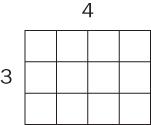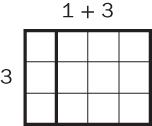Teaching the Common Core Math Standards With Hands-On Activities, Grades 3-5 (18 page)
Read Teaching the Common Core Math Standards With Hands-On Activities, Grades 3-5 Online
Authors: Judith A. Muschla,Gary Robert Muschla,Erin Muschla-Berry
Tags: #Education, #Teaching Methods & Materials, #Mathematics, #General

Measurement and Data: 3.MD.7
“Geometric measurement: understand concepts of area and relate area to multiplication and to addition.”
7. “Relate area to the operations of multiplication and addition.
a.
“Find the area of a rectangle with whole-number side lengths by tiling it, and show that the area is the same as would be found by multiplying the side lengths.
b.
“Multiply side lengths to find areas of rectangles with whole-number side lengths in the context of solving real-world and mathematical problems, and represent whole-number products as rectangular areas in mathematical reasoning.
c.
“Use tiling to show in a concrete case that the area of a rectangle with whole-number side lengthsand
is the sum of
and
Use area models to represent the distributive property in mathematical reasoning.
d.
“Recognize area as additive. Find areas of rectilinear figures by decomposing them into nonoverlapping rectangles and adding the areas of the nonoverlapping parts, applying this technique to solve real-world problems.”
Background
The area of a rectangle can be found by counting the number of tiles that cover it with no part of the tiles overlapping. Think of a rectangle as being a grid, consisting of rows and columns.
In the example below, because the rectangle has 3 rows with 4 squares in each row, the area is or 12 square units.
or 12 square units.

The way to express the area of a rectangle can vary. The rectangle above may be decomposed into two rectangles as pictured below. The 4 columns can be redrawn as resulting in a 1-by-3 rectangle and a 3-by-3 rectangle. (
resulting in a 1-by-3 rectangle and a 3-by-3 rectangle. (
Note:
To avoid confusion with terminology, a square is a special type of rectangle.)

The area of the previous rectangle can be found by using the distributive property: The sum of nonoverlapping parts can be used to find the total area, showing that area is additive.
The sum of nonoverlapping parts can be used to find the total area, showing that area is additive.
Activity 1: Tiling and Finding Area
Students will tile a 3-inch-by-5-inch index card, and then find the area by multiplying the lengths of its sides. They will solve a real-world problem by multiplying the sides of a rectangle to find area.
Materials
One 3-inch-by-5-inch index card; about 20 1-inch square color tiles for each student.
Procedure
1.
Explain that students will find the area of an index card by tiling (covering it with 1-inch squares).
2.
Explain that students should cover the index card with the 1-inch squares completely, without leaving any gaps or having overlapping squares. After they have completed their tiling, ask: How many 1-inch squares were needed to cover the index card? (Students should have found 15.) Note that this is the area of the index card.
3.
Tell your students to find the area of the index card by multiplying its length times its width.

